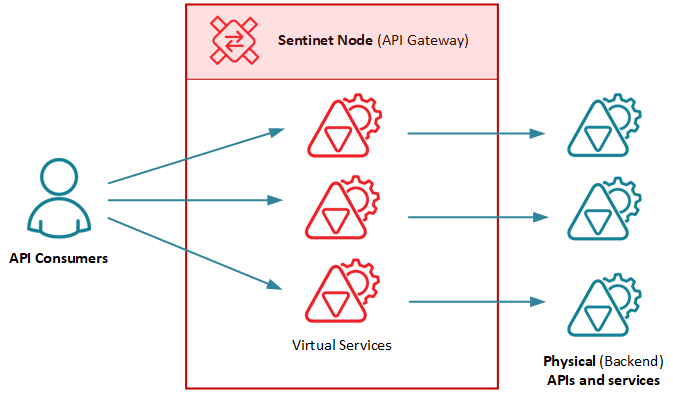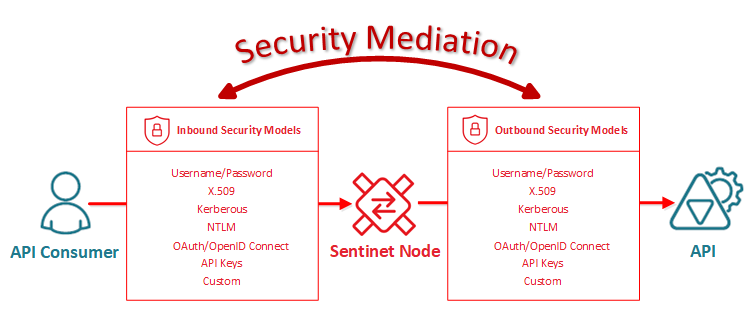Introduction
Nevatech Sentinet API Management helps developers build, provide and consume APIs using industry standard and custom security models. Developers can delegate some, or all of the responsibilities to handle security on behalf of the API Provider or API Consumer applications to Sentinet. These API Security Management capabilities provided by Sentinet tremendously reduce time and efforts on developing, testing and operating APIs in secure on-premises, cloud or hybrid environments.
Sentinet Node (API Gateway) is a high-performance, scalable software intermediary that hosts remotely configurable and dynamic virtual APIs (façade APIs). The Sentinet Node mediates communication between API consumers and physical (backend) APIs, microservices and services, and through that brokerage empowers API solutions with remotely managed security.

Sentinet manages security independently at both the Inbound (virtual API) and the Outbound (backend API) message flows of a Sentinet Node, therefore creating the opportunity mediate (translate) security and/or pass it through between API Consumers and backend APIs. Inbound flow defines security for the virtual service, which is accessed directly by an API Consumer via Sentinet Node endpoint(s). Outbound flow defines security required by the backend API. Sentinet Node implements that security to sucesfully forward request and responses to and from the backend API’s endpoint(s).

Security Mediation and Translation
Sentinet can mediate and translate the security of Inbound and Outbound sides. Inbound and Outbound security models can be the same (pass-through security models), or they can be very different. For example, an on-premises backend API may require Windows Integrated security authentication with local Active Directory, while it is exposed externally as a virtual API requiring Username/Password, X.509 certificate or OAuth JWT token.
Sentinet does not limit supported Inbound and Outbound security models. Any supported security model can be applied at either Inbound or Outbound side.

Security Models
Inbound or Outbound message flows can implement and enforce many different security authentication models with different user credentials and security token types. These can be industry standard authentication schemes and security tokens, as well as custom security models. Sentinet enforces both authentication and authorization to ensure complete end-to-end security.
Authentication
Sentinet supports standard and custom authentication schemes for both RESTful APIs and SOAP services. Tables below provide high-level overview of available options.
For RESTful APIs |
Security Token Type | Authentication Model | Security Level |
Username / Password | Basic Authentication | Transport |
Username / Password | Windows Integrated | Transport |
Username / Password | Custom | Transport, Message |
X.509 Certificate | Single-sided SSL | Transport |
X.509 Certificate | Mutual SSL | Transport |
JWT | OAuth/OpenID Connect | Transport |
Kerberos, NTLM | Windows Integrated | Transport |
API Keys | Custom | Transport, Message |
Custom Tokens | Custom | Transport, Message |
For SOAP Services |
Security Token Type | Authentication Model | Security Level |
Username / Password | Basic Authentication | Transport |
Username / Password | WS-Security | Message (XML SOAP Security Header) |
Username / Password | Windows Integrated | Transport |
Username / Password | Custom | Transport, Message |
X.509 Certificate | Single-sided SSL | Transport |
X.509 Certificate | Mutual SSL | Transport |
X.509 Certificate | WS-Security | Message (XML SOAP Security Header) |
Kerberos, NTLM | Windows Integrated | Transport |
Kerberos, NTLM | Windows Integrated | Message (XML SOAP Security Header) |
SAML | WS-Security | Message (XML SOAP Security Header) |
JWT | OAuth/OpenID Connect | Transport |
Authorization
Sentinet provides unique capabilities to create simple to complex Authorization/Access Rules. These can be configured graphically using the Sentinet Console (API Portal) and its Access Rules Designer with a drag-and-drop user interface.

Figure. Example of a complex Access Rule configured in the graphical Access Rules Designer
Sentinet remotely and securely delivers designed Access Rules to the Sentinet Nodes (API Gateway), where they are executed at runtime to enforce Authorization logic. Sentinet implements Attribute-based Access Control (ABAC), where a single Access Rule is a combination of Access Rule conditions, that ultimately grant or deny access to a virtual API or some of its parts such as specific operation or an endpoint.
Sentinet Users are not limited to the set of Access Rule conditions provided by the product. Custom Access Rules components can be developed using entire .NET framework and any of its languages (such as C#) to implement custom authorization logic. The custom components can be added to the Access Rules Designer with no coding required.
Some of the available Access Rule Designer conditions are listed below:
Logical Any (or), And All (and) and Not (not).
Username/Password identity
Windows Active Directory user identity
Windows Active Directory Group membership
Claims validation (ex: validation of claims in JWT tokens issued by OAuth servers, such as Azure Active Directory, Google, Twitter, Facebook, Salesforce, or any other OAuth server conforming to the OAuth specifications).
Request URL validation that can validate any part(s) of the request URL including paths and query parameters (ex. API keys as query parameters)
HTTP Headers validation
HTTP Method validation
Message body validation using Regular expression
Message body validation using XPath
Date/Time schedule validation
Allowed or restricted client IP addresses validation
Access validation by Operation(s’) name(s).
Custom Access Rule conditions implemented in .NET code to extend Access Rules with custom authorization logic.
Bidirectional Security Management
Sentinet’s security management benefits are bidirectional. Sentinet Nodes will protect your API applications with required security, and they will help your API consumer applications to implement security required by somebody else’s (for example partner) APIs.

Security Identities Management
Sentinet can either pass through API consumer identities or convert them from one identity type into another. For example, Username/Password, Windows identities, JWT token, API Keys can all be passed through Sentinet Nodes from the API Consumer to the backend API. At the same time, with Security Mediation and Translation, Sentinet can use an inbound Username/Password to generate the outbound Kerberos token, or replace inbound claims in a JWT token with a specific X.509 certificate required by the outbound security. Many security token types, listed in the Authentication section above, can interchangeably replace one another, while the messages are being processed by the Sentinet Nodes.